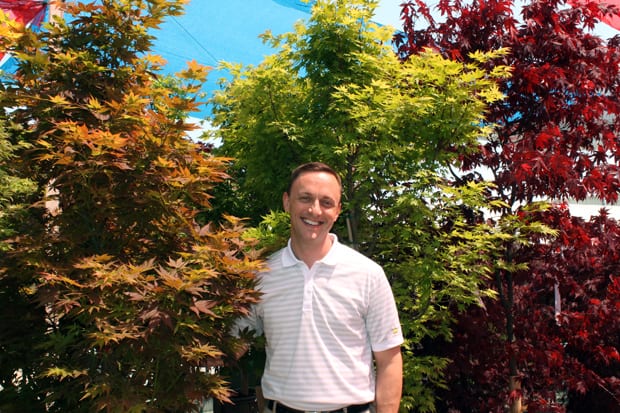North Haven Gardens’ Cody Hoya knows how to make your garden grow … even in Texas’ brutal summer heat

Cody Hoya, general manager of the
very gay-friendly North Haven Gardens, stands among the lush Japanese maples.
Photography by Arnold Wayne Jones.
JONANNA WIDNER | Contributing Writer

Ahhh, yes, a garden. You can envision it: Flower beds bearing bright pops of color. Maybe some cute little shrubs or even some veggies. Your home surrounded by lush vegetation and vibrant blooms.
The fantasy is easy; it’s the execution that can be difficult. How to start? What plants will do best? What kind of soil does North Texas even have, anyway? What the heck should you plant in a part of the state that can swing wildly from flood to drought, freezing cold to boiling hot?
Hold up there, cowboy. Don’t freak out. Here’s what you do: Take a deep breath. Maybe do a quick meditation. You better? Good, now here’s your first step: Go outside and take a look around.
“My very first tip would be to take the time needed to understand your existing property or space and how you wish to use it,” says Cody Hoya, general manager of North Haven Gardens, when asked how the heck to start a garden. So take a stroll around your property and, as Hoya suggests, “take into consideration any existing plantings and vegetation that will affect future planting space, as well as existing structures and paved areas.” Even if the area is new construction with nothing planted, “it’s important to take the time to observe how sunlight falls across the space: what areas are exposed to full sunlight and what areas are primarily shade.”
Another thing to note: “Pay attention to how water moves across your space; if there are areas of runoff where erosion needs to be addressed or if there are places holding water and creating boggy conditions.”
Next, make an assessment of how much time (and money) you can realistically devote to your garden. The planning, prep and planting are just the beginning; there will always be maintenance and upkeep. “Balancing your expectations with your desired investment will determine the gratification you receive from your garden and landscape long-term,” Hoya says.
OK, so you’ve taken stock of your space, locked down how much you want to invest money- and time-wise. Now what?
In order to start narrowing down what kind of vegetation you want (be it decorative or edible), you want to take climate, soil and water use into account.
Climate. “DFW’s climate is a challenging one for gardeners,” Hoya says, citing winters that can be very cold and the blazing hot summers. He also notes that most DFW rainfall occurs between November and May, “so plantings — especially trees, shrubs and perennials — do best when planted early and given a chance to establish a vigorous root system before summer heat sets in.”
Soil. “Most of the soil in the Dallas area is montmorillonite clay, which tends to be sticky, heavy and alkaline,” Hoya says. The lowest-maintenance vegetation is tolerant of such soil, while others require amending with organic material or other additives. For edible gardens, Hoya says that raised beds are a good alternative to amending native soils, because those beds give the gardener more control over the soil. Ask your local garden shop for plant suggestions best suited to your soil, and what kind of amendments you might need.
Timing. An oft-overlooked element of gardening is timing. “Due to our seasonal temperature and rainfall variations, it’s imperative to time your plantings so that your plants have the best chance of success, especially with edibles,” Hoya says.
Water use. “Even if water restrictions are less severe after the spring rains we’ve had, we know that water is a precious resource and it’s a good long-term investment to make wise decisions when planting,” Hoya says. Choosing xeric or low-water-use plants is always a good idea, but Hoya also notes that water-wise plants still will require regular watering for a while just after they’re planted, until they are established.
If you’re going the water-wise route, Hoya suggests ornamental grasses like Mexican Feather Grass (Nasella tenuissima) and native perennials like Blackfoot Daisy (Melampodium leucanthum) as a good start.
Pests. Scale, spider mites and aphids “are ever present,” Hoya says. In general, a healthy organic landscape tends to take care of itself regarding pests with beneficial insects like ladybugs and trichogramma wasps (which can even be purchased), and while mites may cause cosmetic damage, they rarely are destructive. There is one exception, says Hoya: Rose Rosette disease, caused by the eriophyid mite, causes quite a bit of damage to rose bushes and is reaching epidemic levels.
Resources. Look for area Independent Garden Centers (IGCs) for plant varieties that do well in North Texas. NHG provides a number of handouts with details on recommended planting dates, varieties and cultivation techniques. “We also do most of the homework for you ahead of time by selecting species and varieties that we know will have an increased chance of success in our area,” Hoya says.
The Dallas County Master Gardener’s website is a comprehensive resource for research, and the master gardeners also take questions via the site. Well known Texas horticulturalist Neil Sperry’s site is also an excellent resource for general or specific information.
Remember: A garden is more than plants thrown in the ground, but with a little thought and planning, they can be a lifelong joy. “Plants are living things, and living things vary and have infinite responses to their environments,” Hoya says. “You get to know them as you do people, over time, and through understanding their needs and individual personalities.” •
For more information and one-on-one consulting, visit North Haven Gardens, 7700 Northaven Road. NHG.com.
This article appeared in the Dallas Voice print edition April 24, 2015.
















